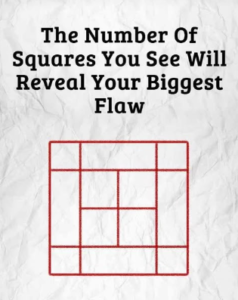The Number of Squares You See Will Reveal Your Biggest Flaw?
Exploring the Illusion, the Myth, and the Real Path to Self-Understanding
It starts with a grid. A simple image of intersecting lines, prompting you with a question: How many squares do you see? The answer, you’re told, unlocks a truth about you — perhaps a flaw. Scroll a little further, and suddenly you’re reading that seeing 16 squares means you overthink, or 20 means you’re a perfectionist. It feels oddly personal, maybe even accurate. But how?
This viral psychological illusion taps into something deeper than our visual perception. It plays with the brain’s need for order, meaning, and — more intriguingly — identity. These types of puzzles masquerade as insight. They seem scientific, almost diagnostic, when in reality, they function more like horoscopes: broad, ambiguous, and designed to apply to a wide audience.
So why are we so drawn to them?
Part of it lies in cognitive bias. The Barnum effect — where vague, general statements are perceived as highly accurate for us personally — is in full play. When you’re told that seeing a certain number of squares means you struggle with self-doubt, your brain eagerly connects the dots, recalling recent insecurities. You relate, and the illusion feels like revelation.
But there’s also a myth at the heart of it: that flaws are singular and diagnosable by shortcuts. That by spotting squares in a box or picking a color in a quiz, we can be told “what’s wrong” with us. It’s comforting, in a way. Simpler than deep introspection. Safer than therapy.
Yet real self-understanding doesn’t come from optical illusions or viral psychology. It takes reflection, honesty, and a willingness to confront uncomfortable truths. Our “flaws” — if we even want to call them that — aren’t always weaknesses. Sometimes they’re strengths used in the wrong context. Overthinking, for instance, isn’t bad; it’s often the engine behind creativity, strategy, and empathy. But left unchecked, it can spiral into anxiety.
Instead of letting an illusion define you, use it as a starting point. Ask yourself: Why did that description resonate with me? Was there truth in it, or just clever wording? What traits do I actually notice in myself — and where do they come from?
Self-understanding is messy, layered, and deeply personal. It isn’t about identifying a singular flaw but noticing patterns, habits, reactions. It’s built over time, through relationships, challenges, and growth. And unlike viral images, it doesn’t offer instant clarity — but it gives you something better: control over your own narrative.
So next time you’re faced with an illusion that promises to expose your flaws, take it with a grain of curiosity rather than truth. The number of squares you see doesn’t define your worth — but the questions you ask afterward just might.
